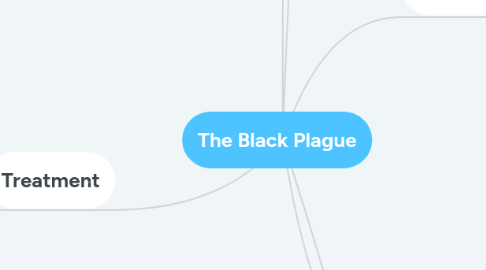
1. Pathophysiology
1.1. Incubation Period:
1.1.1. Someone exposed to Yersinia pestis through the air would become ill within 1-3 days.
1.1.2. 2-6 days, when the bacterium is actively replicating.
1.2. Types of Plague:
1.2.1. Bubonic Plague
1.2.1.1. Symptoms:
1.2.1.1.1. General malaise, fever, muscle aches, gangrene, headache and chills occur suddenly at the end of the incubation period, extreme weakness, swelling of lymph nodes resulting in buboes, the classic sign of the bubonic plague.
1.2.1.1.2. Death can occur within 2 weeks.
1.2.2. Pneumonic Plague
1.2.2.1. Symptoms
1.2.2.1.1. Fever, chills, coughing, chest pain, sneezing, rapid breathing, dyspnea, hemoptysis, lethargy, hypotension, shock.
1.2.2.1.2. 100% mortality if not treated.
1.2.3. Septicemic Plague
1.2.3.1. Symptoms
1.2.3.1.1. Nausea, vomiting, diarrhea, abdominal pain, hypotension, hepatosplenomegaly, delirium, seizures in children, shock, general malaise fever.
1.2.3.1.2. Patient may die before any symptoms appear.
2. Treatment
2.1. Antibiotics within the first 24 hours are very beneficial, with intravenous being preferred in pulmonary or advanced cases.
2.2. Antibiotic treatment alone is insufficient for some patients, who may also require circulatory, ventilator, or renal support.
3. Role of Public Health Nurse
3.1. Surveillance and Reporting
3.1.1. At the state level, healthcare providers and healthcare facilities are required to report certain infectious diseases to the state health departments.
3.1.2. State public health departments that monitor disease incidence and identify possible outbreaks within their states report these data to the CDC.
3.2. Isolation
3.2.1. If the patient has pneumonic signs, they should be isolated, and placed on droplet precautions.
3.3. Standard Precautions
3.3.1. Avoid contact with sick or dead animals, especially rodents.
3.3.2. Avoid contact with the nests and burrows of of rodents, squirrels, chipmunks, and prairie dogs.
3.3.3. If exposure to rodent fleas is anticipated, apply insect repellent containing DEET to the skin.

